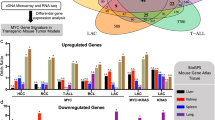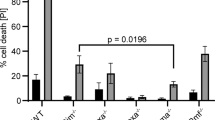Abstract
The transforming gene of avian myelocytomatosis virus MC29, v-myc, causes a variety of malignancies in chickens1. A cellular homologue2, c-myc, has been implicated in B-cell malignancies in mice and humans3–6 but is also expressed in many normal cell types7 and may be important in the control of normal cell proliferation8, c-myc is highly conserved in vertebrates9. We have been investigating the relationship between c-myc expression and the terminal differentiation of cultured mouse erythroleukaemia (MEL) cells. We find that the level of c-myc messenger RNA shows a rapid biphasic change in MEL cells induced to differentiate by dimethyl sulphoxide or hypoxanthine. The changes occur during the first few hours of the differentiation programme and require active protein synthesis. These data suggest that changes in c-myc expression may be important in the irreversible commitment of MEL cells to terminal erythroid differentiation.
This is a preview of subscription content, access via your institution
Access options
Subscribe to this journal
Receive 51 print issues and online access
$199.00 per year
only $3.90 per issue
Buy this article
- Purchase on Springer Link
- Instant access to full article PDF
Prices may be subject to local taxes which are calculated during checkout
Similar content being viewed by others
References
Graf, T. & Beug, H. Biochim. biophys. Acta 516, 269–299 (1978).
Sheiness, D. & Bishop, J. M. J. Virol. 31, 514–521 (1979).
Taub, R. et al. Proc. natn. Acad. Sci. U.S.A. 79, 7837–7841 (1982).
Erickson, J., ar-Rushidi, A., Drwinga, H. L., Nowell, O. C. & Croce, C. M. Proc. natn. Acad. Sci. U.S.A. 80, 820–824 (1983).
Crews, S., Barth, R., Hood, L., Prehn, J. & Calame, K. Science 218, 1319–1321 (1982).
Dalla-Favera, R., Bregni, M., Erikson, J., Patterson, D., Gallo, R. C. & Croce, C. M. Proc. natn. Acad. Sci. U.S.A. 79, 7824–7827 (1982).
Gonda, T. J., Sheiness, D. K. & Bishop, J. M. Molec. cell Biol. 2, 617–624 (1982).
Duesberg, P. Nature 304, 219–226 (1983).
Watson, D. K., Psallidopoulos, M. C., Samuel, K. P., Dalla-Fevera, R. & Papas, T. S. Proc. natn. Acad. Sci. U.S.A. 80, 3642–3745 (1983).
Friend, C., Scher, W., Holland, J. & Sato, T. Proc. natn. Acad. Sci. U.S.A. 68, 378–382 (1971).
Marks, P. A. & Rifkind, R. A. A. Rev. Biochem. 47, 419–448 (1978).
Gusella, J., Geller, R., Clarke, B., Weeks, V. & Housman, D. Cell 9, 221–229 (1976).
Soeiro, R. & Darnell, J. E. J. molec. Biol. 44, 551–562 (1969).
Hsiung, N. et al. Molec. cell. Biol. 2, 401–411 (1982).
Calza, R. E., Eckhardt, L. A., Delgiudice, T. & Schildkraut, C. L. Cell 36, 689–696 (1984).
Kirsch, I. R. et al. Nature 293, 585–587 (1981).
Marcu, K. B., Harris, L. J., Stanton, L. W., Watt, E. R. & Croce, C. M. Proc. natn. Acad. Sci. U.S.A. 80, 519–523 (1983).
Adams, J. M. et al. Proc. natn. Acad. Sci. U.S.A. 79, 6966–6970 (1982).
Gusella, J. & Housman, D. Cell 8, 263–269 (1976).
Rougen, F. & Mach, B. Gene 1, 229–239 (1977).
Schwartz, R. J. & Rothblum, K. N. Biochemistry 20, 4122–4129 (1981).
Alterman, R. B. M. et al. Molec. cell. Biol. 4, 123–132 (1984).
Westin, E. H. et al. Proc. natn. Acad. Sci. U.S.A. 79, 2490–2494 (1982).
Campisi, J., Gray, H. E., Pardee, A. B., Dean, M. & Sonenshein, G. E. Cell 36, 241–247 (1984).
Kelly, K., Cochran, B. H., Stiles, C. D. & Leder, P. Cell 35, 603–610 (1983).
Terada, M., Fried, J., Nudel, U., Rifkind, R. A. & Marks, P. A. Proc. natn. Acad. Sci. U.S.A. 74, 248–252 (1977).
Friedman, E. A. & Schildkraut, C. L. Proc. natn. Acad. Sci. U.S.A. 75, 3813–3817 (1977).
Benoff, S. & Skoultchi, A. I. Cell 12, 263–274 (1977).
Rigby, P. W. J., Dieckman, M., Rhodes, C. & Berg, P. J. molec. Biol. 44, 551–552 (1977).
Levenson, R. & Housman, D. J. Cell Biol. 82, 715–725 (1979).
Author information
Authors and Affiliations
Rights and permissions
About this article
Cite this article
Lachman, H., Skoultchi, A. Expression of c-myc changes during differentiation of mouse erythroleukaemia cells. Nature 310, 592–594 (1984). https://doi.org/10.1038/310592a0
Received:
Accepted:
Issue Date:
DOI: https://doi.org/10.1038/310592a0
This article is cited by
-
Apocynin suppression of NADPH oxidase reverses the aging process in mesenchymal stem cells to promote osteogenesis and increase bone mass
Scientific Reports (2015)
-
Reflecting on 25 years with MYC
Nature Reviews Cancer (2008)
-
GATA-1 forms distinct activating and repressive complexes in erythroid cells
The EMBO Journal (2005)
-
Sensitivity to myc-induced apoptosis is retained in spontaneous and transplanted lymphomas of CD2-mycERTM mice
Oncogene (2000)
-
Mmip-2, a novel RING finger protein that interacts with mad members of the Myc oncoprotein network
Oncogene (1999)
Comments
By submitting a comment you agree to abide by our Terms and Community Guidelines. If you find something abusive or that does not comply with our terms or guidelines please flag it as inappropriate.



